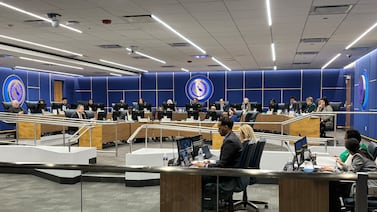Sign up for Chalkbeat Colorado’s free daily newsletter to get the latest reporting from us, plus curated news from other Colorado outlets, delivered to your inbox.
At an April school board meeting near Colorado Springs, debate raged over a proposed policy to ban transgender students from playing on school sports teams that match their gender identity.
A high school student named Sadie, who spoke against the policy, asked why her district would need a blanket policy when a tiny percentage of student athletes are transgender.
A 60-year-old man who supported the policy and described himself as stronger than any woman in the building claimed a transgender girl could slam a ball into a girl’s head hard enough to put her in the hospital.
A father opposed to the policy said his son, a district student, has an extra X chromosome and suggested gender is more complicated than it seems.
He said of the proposed policy, “We’ve now created a situation where an adult is having a conversation with a minor concerning that minor’s genitalia. That’s gross, it’s disturbing, and potentially a crime.”
The recent discussion in the conservative-leaning District 49 is a sign of the times and foreshadows what’s to come in other Colorado school districts as federal and local officials target transgender youth in sports. It also highlights the shifting legal ground that school officials across the state are treading as they try to reconcile state law protecting transgender people from discrimination with recent executive orders from President Trump that aim to eliminate such protections.
Advocates for trangender youth say they are at greater risk for bullying, isolation, and mental health issues, and that denying them access to sports teams that match their gender identity will only exacerbate those problems. Supporters of policies banning transgender students from teams aligned with their gender identity say it protects girls from getting hurt by transgender players or losing out on playing time, wins, or athletic scholarships.
The policy under consideration in District 49 — “Preserving Fairness and Safety in Sports” — would apply at the middle and high school levels to transgender boys who want to join boys teams and transgender girls who want to join girls teams. It wouldn’t apply to sports that are considered coed, which at some schools includes wrestling. The policy appears likely to pass its final vote Thursday. It won preliminary approval in April in a 3-2 vote.
The policy cites a February executive order from President Trump that threatened to withhold federal funding from any school that allows athletes assigned male at birth to participate in girls’ or women’s sports. In an early test of that threat, the Trump administration settled with Maine and reversed its plan to withhold millions in funding for school meals after the state refused to bar transgender athletes from girls teams.
The three board members who supported it, along with District 49 Superintendent Peter Hilts, in April signed on to a group letter demanding the Colorado High School Activities Association adopt rules “to ensure that boys are not permitted to compete as girls in girls’ sports.”
Brad Miller, District 49’s attorney, acknowledged during the April school board meeting that adoption of the proposed policy could lead to a lawsuit. But he argued the district would win in court because the policy was carefully crafted to survive “any legal challenge under the Equal Protection Clause of the 14th Amendment.”
Waiting and worrying for transgender children
For parents with transgender children, policy debates like the one in District 49 are a worrisome reminder that their kids could be targeted with whispers, complaints, or worse for playing on teams that match their gender identity
Melissa, who lives in the Denver metro area and asked that her last name not be used to protect her family’s privacy, knows this fear firsthand.
Although her 6-year-old transgender daughter enjoyed playing soccer for two seasons, Melissa recently steered the kindergartner away from the sport.
“I’m just very concerned about the current political environment that she would be potentially singled out, even as young as she is,” she said.
Melissa instead signed her up for a dance class, which feels like a safer space these days and which the little girl also enjoys. Still, Melissa feels sad and guilty about the decision, knowing she wouldn’t have done the same thing for her son, who loves team sports like soccer and basketball.
“If her gender was not on the table, I probably would have signed her up for soccer this season,” said Melissa. “But … unless she’s really kicking down the door begging for it, I’m not going to continue to expose her to something that might be a major issue down the line.”
In the April letter to the Colorado High School Activities Association, more than 60 school board members, district leaders, and charter school leaders in Colorado urged the group to change its bylaws and guidance for schools to adhere to President Trump’s executive order on transgender athletes.
“Colorado’s schools and athletic programs, which rely on federal funding, cannot afford to ignore this clear shift in federal policy,” the letter said.
It also referenced Title IX, a 1972 civil rights law that banned discrimination on the basis of sex in education programs and activities, saying, “Beyond compliance, however, our demand is rooted in a fundamental commitment to our female students.”
Currently, the Colorado High School Activities Association, which governs high school sports in the state, recognizes the right of transgender students to join school sports teams that match their gender identity and offers guidance to school districts on the topic.
But in recent weeks, the association has struck a more noncommittal tone. At an April meeting for members of the group’s legislative council, Alex Halpern, the group’s lawyer, described its stance on the letter from the District 49 officials and more than 50 other district leaders around the state as “neutral.”
“Our position is, and has been, that ultimately, the determination of who is going to be eligible to participate on a particular interscholastic team at a particular school is a decision to be made by that school as guided by its board of education and consistent with the principles of local control,” he said.
How many transgender student athletes are there?
It’s impossible to know how many transgender students in Colorado participate in middle or high school sports or how often conflicts arise because of it.
The Colorado High School Activities Association doesn’t collect data on transgender student athletes. A spokesperson for the group said its bylaws allow it to review a school’s decision on gender assignment for the purpose of athletic eligibility, but it has not been asked to conduct such a review in the 17 years the bylaw has been in place.
Officials in District 49, a 27,000-student district in El Paso County, didn’t offer much evidence that trangender girls are jeopardizing safety or fairness for cisgender girls, meaning those assigned female at birth.
Hilts, the superintendent, did provide one example during an April school board meeting. He told of a district high schooler who during a group discussion recounted how her varsity girls soccer team had played against a team from another district that included a “whole male.” That player scored twice on penalty kicks and the District 49 team lost.
Although Hilts said he hadn’t heard of a similar situation during his 12 years working in the district, he said the anecdote informed his thinking about transgender athletes.
“That’s a real example,” he said. “As a general practice of policymaking, I give a little more weight to real examples.”
It’s not clear from the anecdote if the player who scored was, in fact, transgender or if the District 49 team would have won the game if that player had not participated.
Lori Thompson, president of the District 49 school board, said she knew of one instance of a transgender student in district sports. It was a transgender boy who sought to join a boys team. He was allowed to try out, but didn’t make the cut.
Thompson said the policy is not meant to disrespect or disenfranchise one group of students, but acknowledged that a transgender student might feel disenfranchised if they are barred from a team.
Thompson likened the policy to proactive protection in case of unforeseen disasters.
“You don’t buy homeowners insurance once your house is burned down,” she said.
Connie Lloyd, a district resident who spoke at the April meeting, cast doubt on the need for the policy.
“Is this even an issue in D49?” she asked. “How many transgender females are playing on female sports? How many transgender males are playing on male sports? Is this an issue, or is it just something made up in Washington?”
Ann Schimke is a senior reporter at Chalkbeat, covering early childhood issues and early literacy. Contact Ann at aschimke@chalkbeat.org.






